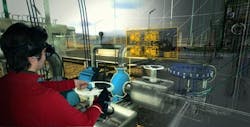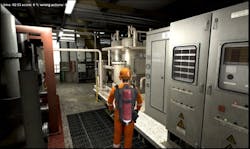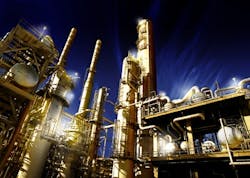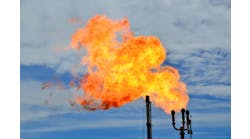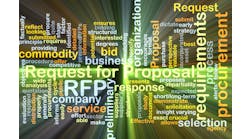More and more trainees in the chemical industry are experiencing an enhanced visual “reality” that improves their learning. Developments by Schneider Electric, ABB and Yokogawa exemplify the trend.
While virtual reality (VR) technology — total immersion in a 3D scene — is more established, Schneider Electric, Andover, Mass., believes augmented reality (AR) and mixed reality (MR) will become increasingly important as advances occur in both hardware and software.
The company considers AR to be a tablet- or mobile-phone-based experience where a user looks at a live camera feed on the screen with a 2D or 3D object or information overlaid. In contrast, MR involves a user wearing a holographic computer that creates 2D/3D augmented graphic images on a lens.
“Increased processing power and reduced size of the AR tablet and MR wearable devices together with rapid advances in computer vision approaches for 2D and 3D scene recognition, coupled with information and asset management software, will enable new ways for the workforce to carry out their daily operations and create new efficiencies and ways to collaborate,” explains Peter Richmond, AR/VR business development director, Sale, U.K.
Figure 1. Training course uses an immersive simulator to evaluate competency. Source: Schneider Electric.
For MR, one device that Schneider is working with is the Microsoft HoloLens headset.
“We are getting great feedback from users on how very realistic it is. So far, it has been used in training on normal and abnormal SOPs [standard operating procedures], emergency preparedness, panel- and field-team training, and plant familiarization. The trainees really believe what they are seeing and completely engage with it,” he says.
The company particularly is focusing now on switchgear maintenance using the HoloLens to demonstrate how wearable MR applications may impact field personnel in the future.
Using a digital twin of the switchgear, the HoloLens allows staff to visualize hidden details, such as an exploded view of the internal mechanisms, or can lead them step-by-step through a maintenance procedure.
“Having the information in front of the operators’ eyes as they are looking at the real device with hands free to operate will be a powerful way to train for and carry out maintenance tasks in the future,” Richmond believes.
HoloLens is perfect for showcasing the potential of these technologies but for now mostly will serve for training and design duties until a version is certified for harsh industrial environments, he adds.
Schneider continues to work closely with Italian refining company ENI, Milan, one of the earliest adopters of 3D simulation technologies. In 2010, for example, the refiner pioneered the use of EyeSim 3D simulation training kiosks (from Invensys, a company since acquired by Schneider) for operators at its Gela refinery on the southern coast of Sicily, before deploying them in other sites around the world.
“We are still partners and have been working recently with the upstream R&D group on how immersive training and enhanced operation applications of AR, MR and VR technology can impact their operations. The solutions range from a tablet-based plant information system to the more classic immersive training system for training panel and field operators,” Richmond says.
Different customers use immersive training in different ways, he notes: “It gives you the ability to do more coordinated training, so for example you can use it to study reactions and communications between control room operators and field operators. There are lots of soft benefits like this — i.e., teaching a team to be a team.”
For many years, simulation-based training of panel operators has been considered a best practice. This involves creating photorealistic real-time VR environments that allow the trainee to experience and interact with life-like normal and abnormal plant conditions. The next step is to provide the same level of simulation-based training to field operators.
Figure 2. Virtual reality enables testing of learning by having an operator face a situation. Source: Schneider Electric.
New engineers also can benefit from such simulations. For example, one oil and gas (O&G) company built a simulation model specific to one plant that is fairly representative of all the company’s sites. So, it can do both bespoke training for the particular plant and more generic training for the others.
The company has created a curriculum that includes immersive training. “This allows it to provide more extensive and engaging training courses to help ensure their operators are familiar with the plant operations and the common principles behind their day-to-day work,” he notes. It also is being used for competency assessment (Figure 1).
Another O&G company is looking at it as a tool to be used much earlier in competency training — i.e., in behavioral training,” says Richmond. The idea is to use VR to put people in situations to test their learning (Figure 2).
Emerging cloud deployment technologies and the exponential power increases coming over the horizon in AR, VR and MR hardware will enhance such strategies, he adds.
Getting Up To Speed
In November 2016, ABB Drives launched its HoloLens proof-of-concept aimed initially at improving variable speed drive (VSD) maintenance.
“We just happened to use VSDs in wind parks for the demo. In principle, the technology can be used in any plant and with any type of process plant device,” explains Juho Vuorio, innovation and venture program manager, ABB Drives, Helsinki, Finland.
A mobile device such as a tablet can display the same sort of information — but using the HoloLens lets maintenance trainees experience real-time troubleshooting and spare-parts purchase actions.
“For example, in chemical plants it is critical to know what a particular pipeline is, where it is coming from and going to, and what the condition of the contents is. As long as the data is available, AR can be a great help in visualizing such systems,” he adds.
Putting digital content into the field of vision while a user is looking at a real-life object offers a variety of benefits, stresses Vuorio: “It allows us to do things we can’t do in real life; gamify training of safe working methods; observe trainees’ attention and focus; integrate training management and certification solutions; understand if the user interface of a device is intuitive or causing puzzlement, for example by distracting eye movement; leave virtual notes; and create Wikipedia-like peer-to-peer content for training programs.”
Vuorio is confident that HoloLens technology eventually will become an important tool for both training operations personnel and helping them optimally perform actual duties. However, he admits that it still must overcome safety and cost issues.
ABB also is piloting a remote presence technology that uses a different sort of AR/VR headset to allow an offsite expert to help technicians either working or being trained at customer sites.
“With a VR/AR headset, the engineer can see maintenance instructions for drives and execute the actions immediately. With AR displayed by the device, real-time performance values, easy spare part ordering and maintenance work instructions are brought into the field of vision in an intuitive and prompt way,” Vuorio explains. The technology is gaining acceptance in areas such as planning, commission and testing, he adds, while its use in daily maintenance and training is still maturing.
Vuorio believes that a major shift in training methods is coming — with VR modules increasingly supplementing traditional training methods such as e-learning and tutorials.
Figure 3. Virtual reality can’t replicate some important aspects of plant activities including smell and the weight of components. Source: ABB.
“VR can’t replace hands-on classroom training where, for example, safe working methods with heavy objects needs to be taught. Similarly, while the appearance and sounds of objects can be replicated in VR, their real weight and smell cannot,” he adds (Figure 3).
Another challenge is the growing demand from customers for open interfaces as component suppliers develop their own proprietary VR training modules. “From a user point of view, it’s ideal when you have your full plant in one VR training solution regardless of components with their specific VR training modules,” he notes.
Maintenance Initiative
Yokogawa, Tokyo, has been using a pilot project in Europe as a test bed for integrating its AR and mobile technologies and training operators in their use.
It is working with CF Carbons, Frankfurt, Germany, a manufacturer of R22 (chlorodifluoromethane) used in the production of fluoroplastics. The two companies have deployed AR-enabled tablets to improve calibration and maintenance of over 1,000 components in CF Carbon’s plant.
The seven tablets use three methods of AR for target recognition: optical character reading (OCR) to detect tag identification labels; quick response (QR) code; and near field communication (NFC).
Being able to check parameters quickly and communicate instantly with an operator in the control room helped field workers reduce maintenance time by up to 20%. Time savings of as much as 40% were achieved for tasks that could be completed without need to contact other personnel.
“A clear benefit then is to train operators to improve how they work in the field. Another is to avoid the shutdown/breakdown of significant assets. One plant manager at CF Carbons noted that by making the maintenance situation more visible, this project had prevented a cooler breakdown that could have cost €600,000 (≈$704,000),” says Yousuke Ishii, manager of the incubation department in the innovation center at Yokogawa’s Tokyo marketing headquarters.
A similar project with another customer achieved 20% reductions in both maintenance costs and production losses.
Training is at the heart of attaining such maintenance and servicing benefits. According to Ishii, the technology is being used extensively for on-the-job training in plant floor situations, for example with real-time data to check the safety situation before performing any maintenance work.
“We also have feedback that some customers are using AR and VR to help novices experience how expert operators work by playing back different real-time operating situations to them,” he adds.
This situation will improve in the future, he believes, when fully AR/VR-enabled simulators emerge. For example, the integration of AR and VR technologies with Yokogawa’s existing Mirror Plant simulator would give trainees a vastly improved “real world” view.
Another change to training regimes will come as AR and VR technologies are used to make robotic devices the eyes and ears of engineers dealing with issues in dangerous and difficult environments. Ishii explains: “I think AR/mobile and robotic technologies are seamless. AR/VR, haptic [touch] interfaces and other five-sense-related technologies should be converged into robotic technologies.”
Lifecycle Focus
For five years, BASF, Ludwigshafen, Germany, has been collaborating with the Fraunhofer Institute for Factory Operation and Automation, Magdeburg, Germany, on developing VR technologies covering the whole plant lifecycle.
One important innovation here is a 6-m-high, 360° projection surface that uses the Institute’s own VR software and BASF meta data to create 3D models almost identical to real plants in Ludwigshafen.
The faithful reproduction of plant data allows plant operators, planners and others such as piping and steelwork contractors, equipment and instrument engineers, and safety supervisors to view details of the plant reproduced at full scale in the virtual model.
BASF was so impressed with the accuracy and detail of the reproduction, particularly in terms of better understanding accessibility to all the plant’s components, that it set up two VR stations in its Ludwigshafen headquarters building. Planning and review teams now use these as both operational and training tools.
Similar VR technology also is serving to develop retrofit projects. Initially, the Fraunhofer experts designed a scenario to retrofit a nitric acid plant and then set up a mobile VR training station directly in the control room at Ludwigshafen. This enabled workers to view all the meta data such as serial numbers, temperatures, pressures and media as well as training materials — and thus familiarize themselves with the retrofit’s operation, identify new access points and learn updated safety regulations.
The same technique now is being used by BASF for training staff embarking on other retrofit projects.
A spokeswoman notes that the collaboration between BASF and the Institute is ongoing via various working groups.
She adds that while VR models are helping to train planning and operations teams to develop and execute projects more successfully, digitalization also is an important development in the chemical industry.
“Trainees who want to become electronic engineers, for example in automation technology, learn how tablets and QR codes can support the maintenance of equipment. As digital tools such as tablets and VR applications are in use at production facilities and in plant engineering, working with them is part of the curriculum,” she notes.

